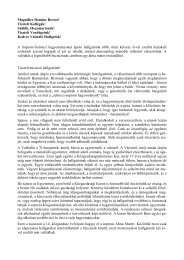Floral Nectar Production and Nectar Sugar Composition of ...
Floral Nectar Production and Nectar Sugar Composition of ...
Floral Nectar Production and Nectar Sugar Composition of ...
You also want an ePaper? Increase the reach of your titles
YUMPU automatically turns print PDFs into web optimized ePapers that Google loves.
International Scientific Conference March 26-27 2012<br />
on Sustainable Development & Ecological Footprint Sopron, Hungary<br />
Significant differences were found among Cotoneaster species, regarding both the<br />
total area (Figure 5 <strong>and</strong> 6) <strong>and</strong> the largest thickness <strong>of</strong> the nectary (Table 1), both in 2007 <strong>and</strong><br />
2010.<br />
<strong>Nectar</strong>y size (µµm 2 )<br />
<strong>Nectar</strong>y size (µm 2 )<br />
500 000<br />
450 000<br />
400 000<br />
350 000<br />
300 000<br />
250 000<br />
200 000<br />
150 000<br />
100 000<br />
50 000<br />
400000<br />
300000<br />
200000<br />
100000<br />
C. laxiflorus<br />
C. roseus<br />
C. saxatilis<br />
C. lucidus<br />
C. prostratus<br />
C. tenuipes<br />
C. ambiguus<br />
4<br />
C. x 'Bella'<br />
C. hurusawanus<br />
Cotoneaster species<br />
C. nanshan<br />
C. shansiensis<br />
C. conspicuus<br />
C. monopyrenus<br />
Figure 5. <strong>Nectar</strong>y size <strong>of</strong> cotoneaster flowers in Vácrátót in 2007.<br />
Data are represented as mean ± confidence interval.<br />
0<br />
C.taoensis<br />
C.turcomanicus<br />
3.2. <strong>Nectar</strong> production<br />
C.hissaricus<br />
C.coliaceus<br />
C.chailaricus<br />
C.salicifolia<br />
C.horizontalis<br />
C.highlight<br />
C.salvinensis<br />
C.veitchii<br />
C.glomerulata<br />
C.lanschangensis<br />
C.dielsianus<br />
C.roseus<br />
C.halfhardii<br />
Cotoneaster species<br />
Figure 6. <strong>Nectar</strong>y size <strong>of</strong> cotoneaster flowers in Vácrátót in 2010.<br />
Data are represented as mean ± SD.<br />
C.shikangensis<br />
C.foveolata<br />
C.fangianus<br />
C.insulptus<br />
C.lancasteri<br />
C.simonsii<br />
C.kitaibelii<br />
Cotoneaster species with large nectaries (above 250,000 µm 2 ) produced an average <strong>of</strong><br />
10-18 µl nectar per flower per day, whereas smaller nectaries (below 200,000 µm 2 ) were able<br />
to produce about 5 µl nectar. <strong>Sugar</strong> concentration <strong>of</strong> the nectar varied from 13 to 45%, while<br />
sugar value was in the range <strong>of</strong> 0.5-3.2 mg in 2011 (data not shown).<br />
3.3. <strong>Nectar</strong> sugar composition<br />
The nectar <strong>of</strong> all examined species was hexose-dominant, except for C. dammeri,<br />
whose nectar contained the disaccharide sucrose in addition to the hexoses glucose <strong>and</strong><br />
fructose (Figure 7).





